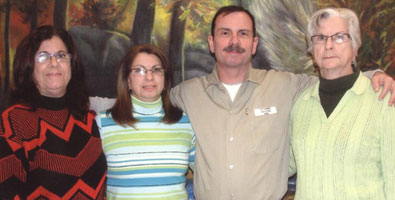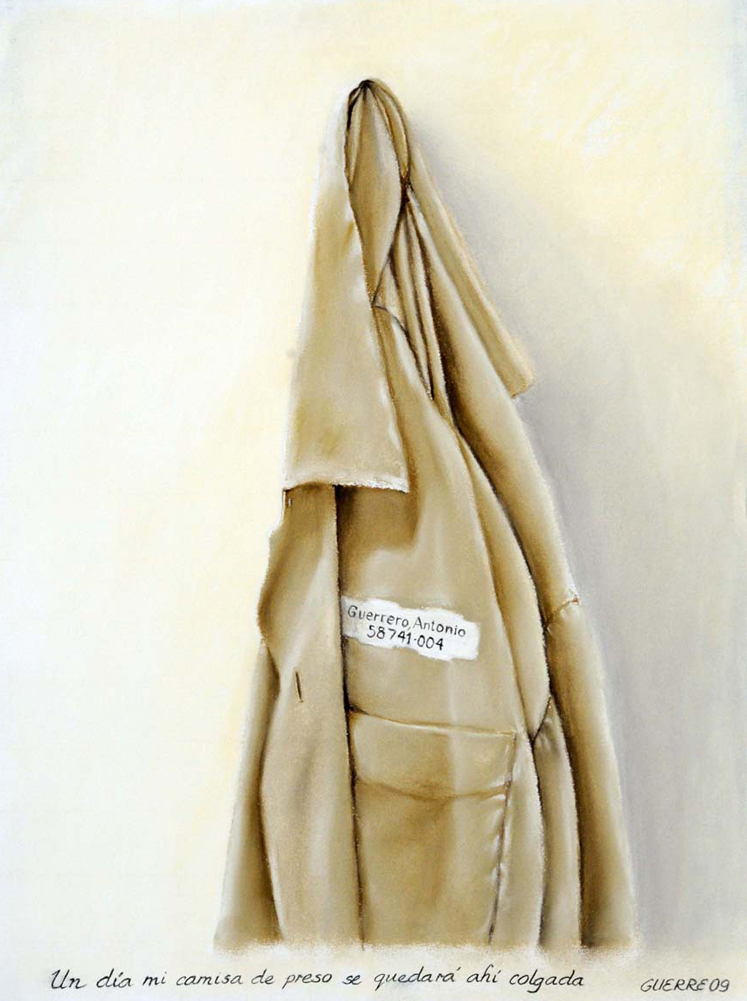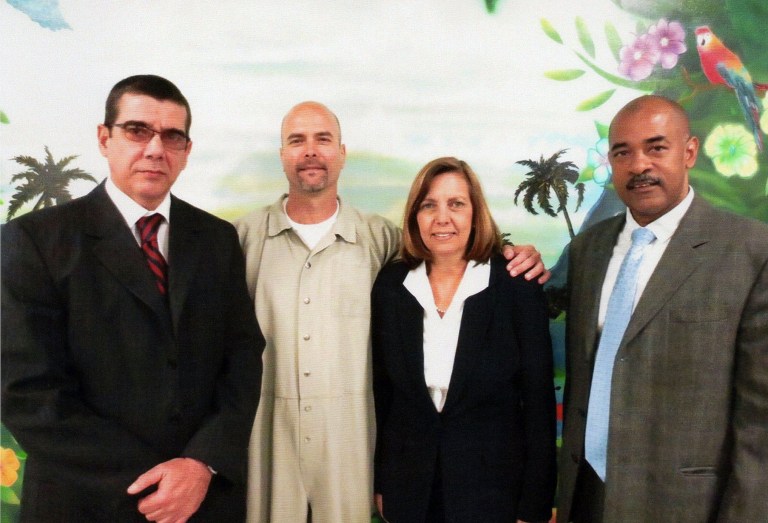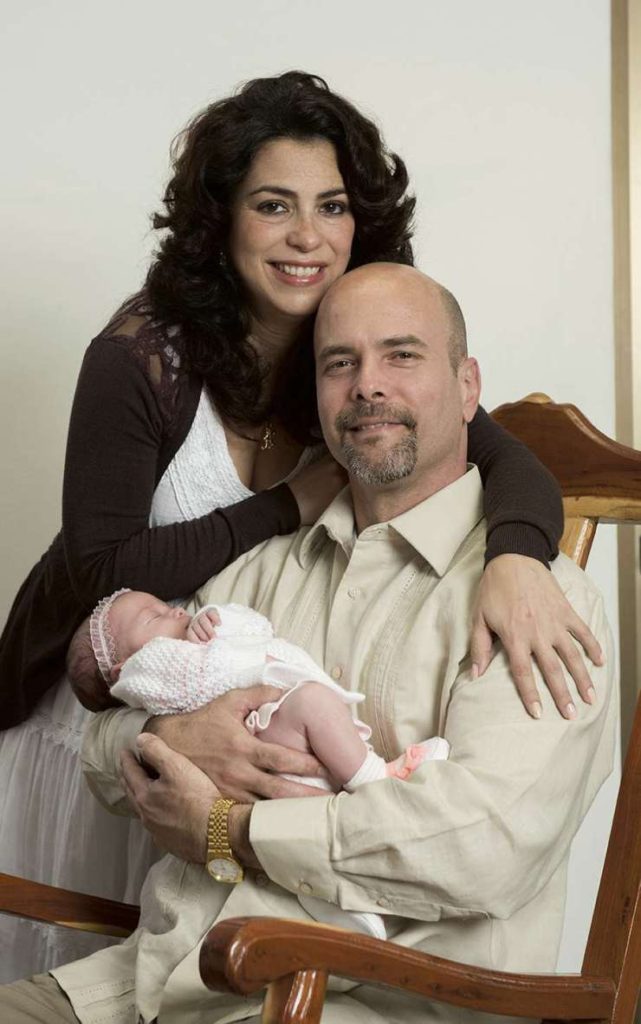On the 25th anniversary of the Imprisonment of the Cuban Five Heroes; Testimonies of Prison Visits
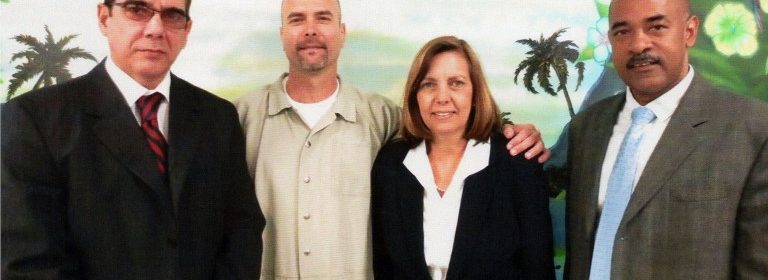
by José Ramón Cabañas Rodríguez
September 12, 2023
reprinted from Cuba en Resumen
translation by Resumen Latinoamericano and the Third World
When I was preparing to assume the responsibility as head of the Cuban Interests Section in the United States (mid-2012), I approached comrade José Anselmo López, who had been in charge of the Consular Section of that office in the late 90s of the 20th century and early 21st century, to ask him about his experiences on visits to U.S. prisons where the Cuban Five Heroes were unjustly held prisoners. I will never forget that when summarizing what we talked about, Anselmo said: “When you visit them you will think that you are the one who is going to give them encouragement and support, but later you realize that it is the other way around”.
That phrase seemed to me to be the result of the respect and admiration we all felt and still feel for those men, rather than a true reflection of reality. But as soon as I completed the first round of visits to those who were still incarcerated, I came to the same conclusion.
I had read much about them, met with their families before leaving, had had access to some of their personal letters, but none of these experiences were superior to meeting them personally and exchanging with them for extended hours.
Above their individual characteristics there were several common points among them and the first one was the full conviction about the work they had done to protect the country from the United States, there were no regrets, no doubts. Infinite love for their Cuba and its people came first. The second was the belief, also without limits, that they were not alone and that they would return to the bosom of their families and the affection of their fellow countrymen, even though the confinement had been extended for many years.
The four of them kept up to date on the national and international situation in Cuba and only asked about small details. They talked about the rest of their “brothers”, as they always called each other, as if they were not separated by thousands of miles between the penitentiaries where they lived. Whenever we visited them, it seemed as if they had been talking to each other until the night before.
And, shockingly, no matter how much information we had to pass on to them about personal matters, or about the legal strategy of their cases, there was never a tear in their eyes, nor were there any signs of despondency on their faces.
Due to coincidences between the rotation of visits and my personal obligations, it so happened that I was able to visit first Fernando Gonzalez Llort, a fellow student (different years) at the Higher Institute of International Relations “Raul Roa Garcia” and brother in arms in the military mission we both served in the People’s Republic of Angola (1987-1989).
I had been alerted that Fernando would wait for visitors to the embassy, their families, or colleagues from solidarity organizations who visited them, stationed somewhere in the facility from where he would see them arrive in the parking lot, without them being able to observe him. He studied the state of mind of each one, their extra-verbal language in the time it took for them to open and enter the facility.
That first visit was in the middle of winter and the prison authorities (each one has its own rules) forced visitors to enter without coats. We had to wait long minutes before entering the facility, in a piece of Arizona desert with strong winds and low temperatures. Fernando saw all the body contortions we did to resist and when he saw us he said: “It’s cool out there, isn’t it? Almost without hearing him I hugged him and, as one does with intimate brothers, I gave him a kiss on the cheek. This was enough for him to launch a second joke: “Hey, what are they going to think of me, you’re leaving, but I’m staying in here”. After hearing that second sentence I asked myself, “But how is it possible that this man after all he has had to face still has the desire to joke?”.
And it turns out it was a very serious sense of humor. It wasn’t the defensive attitude of disrespect for his surroundings, it was a perpetual pondering of what was going on around him, always trying to come to optimistic conclusions.
As it happened with the rest of the Five, practically a book could be written about each of the visits to the prisons with experiences that should transcend, but in the case of Fernando, the experience that has remained in our minds as if it had happened yesterday was the conversation held in the last visit we made to him.
Due to the different length of the sentences that had been imposed on them, Fernando was due to leave the prison after 14 years of imprisonment. In preparation for that moment, we had to ask him a series of questions and clarify others.
The first was related to his consideration as to whether or not, at the precise moment of his release, there would be legal or other impediments to delay the process. In Cuba any number of scenarios had been constructed in this regard and we wanted to know his criteria. To our total surprise Fernando presented a complete analysis on the matter, with both legal and political considerations and it seemed that he knew in advance what we were going to ask him. He concluded by saying “we will go home when that day comes”.
It was always our responsibility to warn them of any difficulties, not to create false expectations in any subject and to speak to them in a very objective manner. But in the certainty of those words we had no comment and just said, perhaps irresponsibly, “that’s the way it will be”.
We had memorized the whole procedure that had been informed by the American side about the time he would leave the prison, the way he would be transferred to the airport, the type of plane that would take him to the last destination before flying to Havana, the time he would be there and the exact time he was to arrive in his beloved Homeland. “The officials of the Migration Service assure that it will be at 11:57 in the morning,” I told him. Fernando had listened to the whole explanation in silence, without interruption, but at that moment he could not help but ask. “And did they tell you the seconds?
At the end of the presentation, with much regret, we had to assume an objective position and tell him: “this is what we have been officially transferred, but as we are not allowed to accompany you, any of these details may vary and I am afraid that we will not have communication in real time to know any variant, and intervene with the authorities”.
Fernando had scanned our thoughts and encouraged us saying, “don’t worry, everything will be fine, we will be home soon, but maybe it will arrive at 58 o’clock”. And again we were assailed by the question of where these men got that reserve of optimism and humor.
He had almost created a code of conduct for himself in prison, ranging from rigor in morning exercises, to the way he dealt with the rest of the prisoners and the prison authorities, in an environment where friendship is a non-existent concept and lack of attention and alertness is a weakness that is paid for with life. We know that he did not miss his routines even once and always slept with one eye open.
The experiences with Antonio Guerrero Rodriguez had another projection. He has three passions (besides politics and family) that define his personality very well: painting, chess and poetry. With these three he created a parallel world to the prison dilemma, with different times and spaces, to such an extent that he felt strongly that his body had restrictions of movement, but his soul was totally free.
It can be said without a doubt that Antonio (we all call him Tony) is a self-taught painter, who grew technically by himself, to eventually become a teacher of other prisoners.
Sharing his love of drawing, we were able to discuss some technical details with him and insist on the invitation to create his own images, after he had spent years trying to create works from photos of flora and fauna sent to him by his family and friends.
Perhaps as a result of one of those discussions, he decided to work on what would be the first exhibition with his own images, which would be shown in several U.S. cities and in Cuba. In the Interests Section we felt we were guarding a very special treasure when we received the works through the mail. My wife spent a whole day using her manual skills to frame and prepare each of the fours. When I proudly told him what she had so lovingly done, I again received a humorous jab, “poor woman, didn’t she have anything more important to do?”, but immediately followed by all his thanks and appreciation for promoting his work, his “little babies”, for all the love he put into each brush stroke.
Few people beyond his family and intimates know that Tony set up a painting workshop in Marianna Prison, Florida, and helped in the artistic training of dozens of inmates. His passion in that exercise earned him the respect of all those around him, even the prison authorities, who were benefited by his superiors in the Bureau of Prisons, for organizing exhibitions of paintings made by the prisoners, something uncommon in those parts.
Tony was permanently busy with what he called his “obligations”: keeping up to date the answers to the voluminous mail he received every day, writing about chess and poetry, to the point of completing books on both passions.
As his pictorial work became known, he also received specific requests. On one occasion he received photos of the three prizes awarded in Cuba in an underwater photography contest. His way of reproducing those images was so perfect, that we dared to ask him for permission to make copies of them to give them as gifts on his behalf to American relations with a fondness for the environment, which he accepted without thinking about it.
In the group of paintings of his authorship that we sent to Cuba on that occasion there was one that moved us: a drawing of his own hands handcuffed behind his back on the day he was arrested. We also asked him for permission to reproduce it, but in this case to keep it with us, in that case he did not accept: “no copies ambassador, I will make an original for you, even if I have to stop sleeping”. And so it was and he complied in a few days.
But that image would enclose yet another secret. In a later visit to the prison, Tony explained to us that when he was doing that job, a prison security officer approached him and out of simple curiosity commented: “What is that Tony, are those your handcuffed hands?” and without thinking he answered: “Yes, my hands, but not my soul”. We asked Tony to write down that anecdote, which he also did, to keep it on the back of the book, where it remains to this day.
Ramón Labañino Salazar’s physique always gave the appearance of being a fighter, or martial arts practitioner. With an extreme self-confidence, perhaps that external image accompanied him when facing any kind of challenge. Of all of them, he was perhaps the one who came closest to a violent conflict with inmates, not to defend himself, but to prevent an elderly cellmate from being mistreated by other convicts.
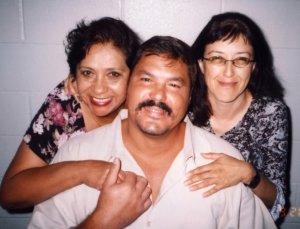
Ramón visited in prison by National Committee to Free the Five activists Rosa Peñate and Gloria La Riva.
The same attitude led him to verbally confront an officer of one of the prisons where he was when he was transferred to a prison with a lower security level, thanks to the years of sentence served and his conduct.
According to the procedures, when that moment arrives, each inmate is asked three preferences about his next destination. When Ramón gave his, the official “joked” that he might be sent to a Miami prison, where he would presumably face greater risks due to the predominantly Cuban-American population. Ramón immediately accepted the challenge, adding that he had nothing to fear.
We will never know if it was an intentional decision or purely by accident, that was Ramon’s momentary fate, until we were able to intervene with the authorities of the State Department and the Federal Bureau of Prisons to have him transferred to another prison. What was significant about that event was that in the first visit after the mishap, Ramon waited for us with a self-critical exercise and apologizing for having acted in a way he considered “thoughtless”, which would have forced us to make extra efforts “unnecessarily”.
We did not succeed in convincing Ramon that this was not a “mistake”, but a normal reaction of any patriotic Cuban who feels the responsibility of representing millions. He himself had told us earlier: “many prisoners who are here the only thing they know about Cuba is ourselves.”
Ramón was the second longest-serving of the Five. Beginning in 2013, when the State Department engaged in a more or less constructive exercise to secure the release of a U.S. national who was on trial and detained in Cuba, they proposed the release of that one in exchange for Ramón’s, excluding the rest.
We fulfilled our duty to inform him about it and to ask for his opinion, which we could almost anticipate. He was seriously offended and without blinking he answered: “but how can they propose that to me, Gerardo (Hernández Nordelo) is the one who has no option to go free, he has been allowed to see his closest relatives very few times, he lost his mother in prison”, to which he added an almost incredible sentence: “with good conduct I should have ten years left here, and with 60 years I will get out of here in one piece”. And as if to leave no doubt and to make sure that this would be our message to Havana, he sentenced: “The priority is Gerardo”.
As if the weight of those words were not enough, he said them looking us straight in the eyes as if to say: “don’t forget a single letter”.
It is also the case of Ramón that the last meeting with him, just before his release, is the one that has left the deepest traces in our memory.
We were all on the sidelines of the secret negotiations that would culminate, among other results, in his release from prison. Nevertheless, in the weeks preceding that visit, signs had been gathering that would indicate that “something was moving”, that could mean at least a change in the status of the Five, a different treatment. At no time did we have the certainty that those signs could mean their definitive freedom.
We had been transmitting each and every one of those public “signals” to Havana, from where we received at every opportunity precise indications of what to inform each one of them during the visits. However, to our surprise, for that last meeting with Ramon in U.S. territory we received a brief message, which in essence said: “give him a summary of your assessment of the situation, tell him what you know”.
Ramón received us with the same affection as always and immediately realized that those would be six hours (duration of the visits) very special in his life. We prepared a presentation as coherent as possible with all the details. Ramón listened without asking questions, without interrupting, to tell us at the end with enormous conviction and capacity for synthesis: “we are leaving, now we are leaving”.
Once again, faced with the responsibility of not suggesting false scenarios, we insisted: “Ramón, these are just a group of assessments based on imprecise information, we cannot create this expectation”. Staring at us, he reiterated with athletic strength: “we are leaving”. As he said goodbye and was led back to the cells with the rest of the prisoners who were visited that day, he raised his fist in victory, this time silently, but with a contagious energy and firmness. He was right.
We always visited Gerardo Hernandez Nordelo at the maximum security prison in Victorville, California, where he spent his last 10 years in prison, even though he was eligible for a mid-range facility. The building itself is imposing, without windows, as if to offer an image of those who are confined there will never return to the outside world.
However, we experienced the paradox that from the main entrance for visitors to the meeting place there was a short distance where you found only five doors (each with its own security measures), which separated from the outside world someone condemned to not enjoy freedom for the rest of his life. It was a physical paradox in the face of legal and political arguments that was synthesized in “as close as far away”.
Gerardo was the one who had received the fewest visits from family members of all of them; he was one of the Five against whom the U.S. authorities were most furious, frustrated by the fact that they had not been able to extract a piece of information from him, a figure that would compromise the other comrades he had led in the task of obtaining information on counterrevolutionary plans.
Gerardo was the one against whom the prosecutors of the rigged trial in Miami created the false charge of conspiracy to commit murder, with the sole purpose of justifying an “exemplary sentence” that would satisfy the desires for revenge of those ringleaders to whom he was very close.
For those same reasons, Gerardo attracted the attention of specialists from special agencies of the United States, who more than once visited him to understand his resistance, because in all the prison manuals of that country it was written that a man with no hope of being released and in the conditions to which he had been subjected “had to leave at some point”.
We remember the appreciation of his last lawyer Martin Garbus, who clearly moved by this resistance confessed to us “I have experience with prisoners of long sentences, men who at some point in the extension of their isolation and in the eventuality of never being free, well, they break. I do not know anyone like Gerardo. His soul is immense and his convictions infinite”.
Gerardo never asked any questions about the times, he never had any anxiety about future things, but neither did he say a sentence about the eternity of his sentence, he never spoke of having no options and never crossed his mind, at least in our presence, the image that one day he might be left alone in the United States, when the rest of his companions were released.
He shared with his visitors without the slightest embarrassment his love for Adriana, a story that can make the stories we know about Ulysses and Penelope pale in comparison. Many times it seemed to us that Adriana was physically part of the visitors, she was there, he saw her and smiled with his memories. We must remember that he was only able to give her a light kiss on three occasions during 16 years, the rest of the love that connected them traveled by phone or letters.
During 2014, a few weeks before their release, it was decided that comrade Josefina Vidal, then director general for the United States in MINREX, would visit the three who were still imprisoned to present them with a report on all the political, diplomatic and legal steps that were being taken to achieve their release. It was an extensive report that Gerardo read in detail and only interrupted the reading to ask a missing piece of information, or to relate a fact with something he had learned from another source.
However, that very serious exercise began with an anecdote that neither Josefina, nor Consul Bencomo, nor I will ever forget in our lives.
The director general had traveled from Havana with only partial knowledge of the in vitro fertilization procedure that had been performed to enable Adriana to conceive Gerardo’s child. Thanks to Senator Patrick Leahy, exceptional arrangements were made, which allowed Gerardo’s semen to be extracted and sent to Cuba, since conjugal visits have been prohibited in U.S. prisons since 1952.
Josefina understood, but was not certain, that the eggs finally inseminated (there had been a previous attempt) had been retained by Adriana and that a happy pregnancy would begin.
The three of us visitors entered the meeting place thinking about the possibility that everything had failed and we prepared ourselves with insufficient arguments to try to give encouragement to someone who was struggling for parenthood. Gerardo appeared with his head down, his gaze elusive and he launched a phrase that froze our stomachs: “Adriana doesn’t want to”. He kept his head bowed and it was our chance to exchange glances and try to assist us in interpreting the moment.
He remained silent for long seconds, to finally throw us a smile and tell us, “Adriana doesn’t want to name her after me!” With that sentence we learned of the existence of who would later become the beautiful Gemma. We hugged briefly, congratulated him and began to talk about the future as if the steel, the armored glass and the walled walls that surrounded us were unreal.
Before long we noticed the way those who were there to watch and enforce the regulations were looking at us. What were those Cubans celebrating in that “dark hole” at the end of the world?
Weeks after that visit, Gerardo, with his permanent observation and ability to orient himself, was the first to offer a sign that freedom was closer to him. He was transferred from Victorville to a transit prison in the center of the United States, just ten days before his final trip to Havana.
In that place, where he knew no one and had no time to make new friends, he was able to access a telephone and call a consul to tell him tersely “I have been transferred without notice and have not been allowed to collect my belongings”. He knew that this information carried with it the fact that the move seemed definitive on the road to freedom and helped us to complete a scenario that was later confirmed. A few days later he would meet with Tony and Ramón in another facility, from where they would travel together to Havana on December 17, 2014.
